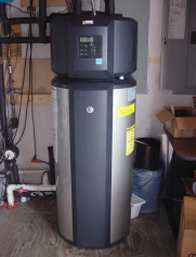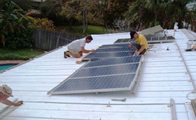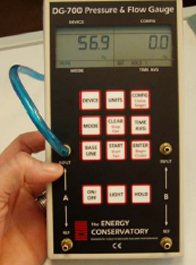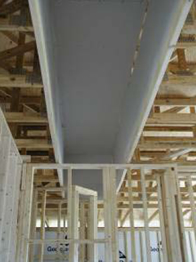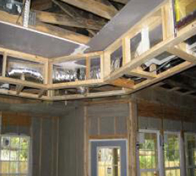 |
FSEC Receives DOE Funding for Advanced Simulation Development
After the first year funding for the project "EnergyPlus Development Assistance" funded by the Department of Energy, the development team led by the Florida Solar Energy Center received the second year funding of $1.328 million from June 2012 to June 2013. FSEC and its six team members develop models to help engineers better estimate the energy use of buildings. |
|
Side by Side Testing of Water Heating Systems: Results from the 2010-2011 Evaluation
The Building America (BAPIRC) team at FSEC has released a report containing results from a second testing rotation (Phase II) on seven hot water systems evaluated side-by side. Results show the seasonal performance variation and compares solar systems against electric resistance and the Heat Pump Water Heater (HPWH). Standard and tankless natural gas were also evaluated, where the latter demonstrated a 24% natural gas reduction. The lowest averaged electric power consumptions were demonstrated by the HPWH (2.75 kWh/day) and the PV-pumped solar water heater (3.03 kWh/day). Other testing performed on the HPWH under conditioned and restricted air space (93 ft3) simulating a closet, resulted in a 14.3% increase of electric use and a 12.8% in COP reduction.
Publication |
Achieving Very High Efficiency and Net Zero Energy in an Existing Home in a Hot-Humid Climate: Long-Term Utility and Preliminary Monitoring Data
This study summarizes the first six months of detailed data collected about a single-family home that experienced a series of retrofits targeting reductions in energy use. The project was designed to develop data about how envelope modifications in heating, ventilation, and air conditioning and domestic hot water and renewable measures can result in considerable energy reductions and potentially net zero energy for an existing home. Using utility billing records and recent detailed monitoring data, this study was also able to chronicle the progress of energy reduction over a 22-year period.
Publications |
Accuracy of the Home Energy Saver Energy Calculation Methodology
The Home Energy Saver (HES) suite offers popular online simulation tools that enable
U.S. homeowners and energy professionals to rigorously evaluate home energy use and develop recommendations on how energy can be saved across all end uses. In this paper we compare measured to predicted energy use for 428 occupied homes in Oregon, Florida, and Wisconsin, representing a diversity building types, energy intensities, and occupant behaviors.
Publication |
Measure Guideline: Managing the Drivers of Air Flow and Water Vapor Transport in Existing Single-Family Homes
Air and water vapor are transported into and within single-family homes as a result of pathways and driving forces. Without pathways, no air or water vapor transport could occur. Likewise, without driving forces, little or no air or water vapor transport will occur. Homes always have pathways and driving forces. This report focuses on managing the driving forces that move air and water vapor across the building envelope.
Publication |
Energy Savings and Peak Demand Reduction of a SEER 21 Heat Pump vs. a SEER 13 Heat Pump with Attic and Indoor Duct Systems
This report presents the results of Phase 1 of a proposed multiyear, multiphase research project. This project characterizes how a SEER 21 heat pump performs compared to a SEER 13 heat pump when operating with: airtight attic ducts; indoor ducts; RH control activated (and without); ducts that leak to attic and outdoors; various installed capacity-to-load ratios; and better insulated ducts.
Publication |
Measure Guideline: Summary of Interior Ducts in New Construction, Including an Efficient, Affordable Method to Install Fur-Down Interior Ducts
This document illustrates guidelines for the efficient installation of interior duct systems in new housing. These guidelines describe a variety of methods to create interior ducts including the fur-up chase method, the fur-down chase method, and interior ducts positioned in sealed attics or sealed crawl spaces.
Publication |
|
Commercial Energy Code and Green Building Modeling Using EnergyGauge Summit
This course will teach you how to use the EnergyGauge Summit software. It is designed for first time and experienced users. Next class offered on November 1, 2012.
View Details |
EnergyGauge Commercial Rater Training
This course is designed to teach the methodology of commercial energy ratings in order to accurately assess commercial buildings. Next course offered on
November 2, 2012.
View Details |
From Blueprints to Residential Energy Code Compliance
The course will provide students with detailed instructions and examples of how to go from a set of blueprints to calculating the residential energy code and detailed instruction on how to perform blueprint "take-offs". Next class offered on December 3, 2012.
View Details |
EnergyGauge Pro Hands-On
Getting maximum use with minimum effort out of Florida's residential Energy Code and Energy Rating Software. Next class offered on December 4, 2012.
View Details |
EnergyGauge Rater Training Class 3, 2, and 1
Become a home energy rater. Classes offered in December.
View Details |
Energy Star Version 3.0 Training
Energy Star version 3.0 will require that the rater, builder and HVAC contractor have been trained in the new programming requirements.
Next class offered on September 19-20, 2012.
View Details |


